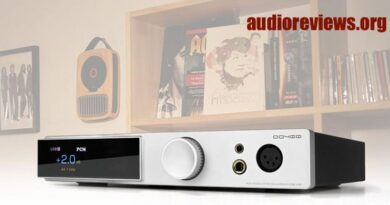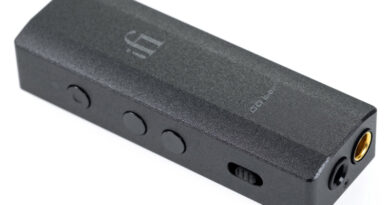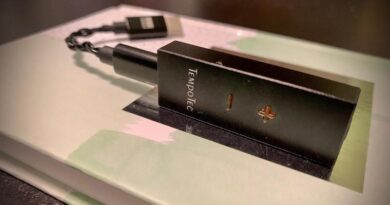Audirect Team 1 ES9281AC Portable USB DAC/AMP – Standing On The Shoulders Of Giants
Nicely machined and very pretty to behold, the nominally $329 ($279 intro) Team 1 is not without its design quirks. At 68mm x 36mm (that’s 2.6in x 1.4in for us colonials) and 67g, the Team 1 is a bit large and bulky for pocketability and a bit small for optimal desktop use—its tiny buttons are frustrating to access and use, and the dual volume buttons, for whatever reason, only work with the USB input.
Unlike some larger units from Pro-Ject or Schiit, connectiviity is limited to USB and Aux inputs (no coax, optical or XLR). However, the color screen, which shows sampling rate and gain mode, has good visibility and aesthetics. My unit was shipped with the optional Bluetooth adapter, which worked well but didn’t sound as good as cabled sources. The Team 1 can be powered either through its USB port or with its internal 1300mAh battery (no battery life is specified, but I tested for around 8 hours without issue).
| In the Box: 1 x Audirect Team 1 User Manual |
The Team 1 immediately registers as a very powerful amp, especially through the balanced (4.4mm) out—even in Low Gain mode my phone got insanely loud with only 40% volume with 32oHm-sensitive IEMs, as opposed to 70% for a typical dac/dongle. I found the Low Gain setting to be more than adequate for most phones—even my 150 oHm Beyers sounded a little overdriven in High Gain. I didn’t have any 600 oHm headphones at hand, but I have no reason to doubt they would be capably driven.
Its output and sound signature can best be described as “clean”—unlike Audirect’s cheaper dongles like the recently-reviewed Atom 3 (review here), aside from a certain fattening of note texture, the Team 1 doesn’t impart any coloration or artificial Imprint on the proceedings. Its sheer power does, however, have the effect of tightening and deepening low end–modest, balanced-sounding headphones like my Koss KSC75 or Senn HD650 take on a sheer physicality and presenting previously unheard (and undistorted) subwoofer presence.
Likewise, the Team 1 does a very good job of separating the performers (there’s no bleed between frequencies) and widening the soundstage—music sounds bigger, albeit without the unnatural adrenalin of lesser pieces. Background noise is virtually absent—there’s no audible static or distortion even on very sensitive IEMs like the KZ ZS10.
Compared to the much pricier SMSL SU-9/SH-9 DAC/amp combo, the Team 1 sounds a little rawer tonally, with less extension at the high end; the SMSL was smoother, sweeter with a more etched bass region. Curiously, though the Team 1 (at least subjectively) sounded more powerful and punchier; I actually preferred it for heavier fare. The Team 1 also compared very favorably to the comparably-priced SMSL SH-6/SU6 (review here), which presents more high-end detail; but also sounds a little edgier and less natural.
Specifications Audirect Team 1
| DAC Chips: 9281AC PRO Operational Amplifier: OPA1612*1+OPA6863*4 Output Interface: 3.5mm SE/4.4mm BAL Frequency Response: 0.083dB@20Hz~40kHz 3.5mm Output Power: ≥2 Vrms (16Ω)≥2.8 Vrms (32Ω)≥2.8 Vrms (600Ω) 4.4mm Output Power: ≥1.5 Vrms (16Ω)≥2.3 Vrms (32Ω)≥5.6 Vrms (600Ω) SNR: -118dB Distortion: + Noise: 0.000004 Sampling Frequency: up to 32-bit/768kHz Support DSD specification: up to DSD512 Weight: 67g Battery Capacity: 1300mAh Size: L68*W36 *H18 mm Tested at: $329 Company Page: Audirect Purchase Link: Audirect Audio Store |
I next compared the Team 1 to my sentimental favorite, the tubed Aune T1 MkII USB DAC/headphone amp, which cost around $219 back in the day. The Aune, predictably, has a much softer, warmer tone that the crisper, neutral-sounding Team 1. The Team 1 is much more powerful and revealing—it’s a VHS-t0-DVD difference—and bass is far more revealing and impactful.
While the Aune has that certain inalienable listenability and matches well with poor-quality and lower-rez recordings, almost everyone would recognize the Audirect as the vastly more refined, expensive-sounding amp. My (DAC-less) $150 Pro-ject Head Box S actually came close to the uncolored, open quality of the Team 1, but also had less drive and consequently sounded flatter and less bassy.
Ultimately, the Team 1 occupies a curious niche in the head-fi world—it’s neither dongle nor big, user-friendly desk unit; its best deployment would be hanging out at Starbucks with your PC and big power-hungry phones. For more mobile use, I’d save some $$ and opt for my new rave, the Hidisz S9 Pro Plus Balanced (review here), which in absolute terms sounds a little grainier/edgier than the Team 1, but is nonetheless an awful lot of amp for $100. Still, ergonomic nits aside, the Team 1 performs on a par with a lot of bigger, pricier units, is difficult to fault sonically and ultimately feels like good value.
Disclaimer: sent to me gratis by Audirect for review purposes and will be moved on to others for their thoughts.









